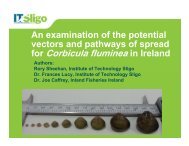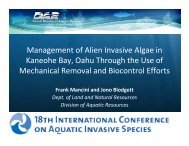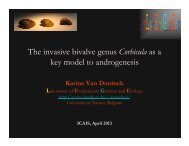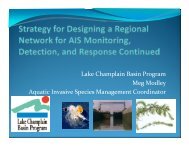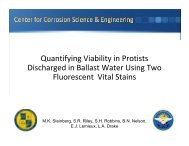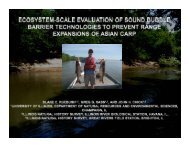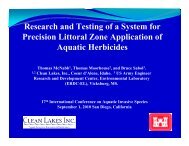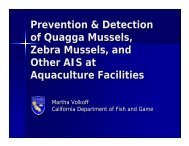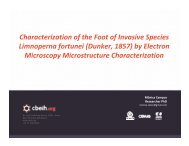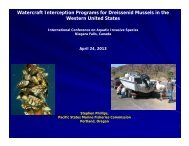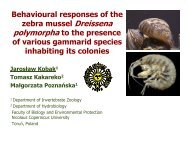PREliMiNARy PRoGRAM - ICAIS
PREliMiNARy PRoGRAM - ICAIS
PREliMiNARy PRoGRAM - ICAIS
Create successful ePaper yourself
Turn your PDF publications into a flip-book with our unique Google optimized e-Paper software.
Preliminary<br />
Program<br />
14th International<br />
Conference on Aquatic<br />
Invasive Species<br />
May 14 to 19, 2006<br />
Key Biscayne, Florida<br />
14th Int<br />
Conference<br />
Inva<br />
May 14<br />
Key Biscay<br />
Hosted by the United States Geological Survey
The introduction and spread of invasive species in freshwater and marine<br />
environments is a worldwide problem that is increasing in frequency and<br />
magnitude. An ever-growing number of aquatic species are being introduced,<br />
becoming established, and causing significant damage to receiving ecosystems,<br />
and resulting in economic penalties and threatening native biodiversity.<br />
An ever-growing number of aquatic invasive species<br />
are causing increasing damage to ecosystems and<br />
the economies that depend upon them.<br />
No ecosystem on the planet is impervious to the onslaught of aquatic invasive<br />
species. Florida’s Everglades National Park, a United Nations World Heritage Site,<br />
is one such ecosystem that struggles with large numbers of invaders that are<br />
changing the Park’s ecosystem and requiring on-going restoration efforts.<br />
In order to protect natural treasures like the Everglades, and other World<br />
Heritage Sites, it is essential to have an integrated and harmonized approach<br />
involving the full range of stakeholders from resource managers and academics<br />
to citizen activists and policy makers. Action must be taken at the local, regional,<br />
national and global levels if we are to stem the tide of aquatic invasive species<br />
that threaten the biological integrity of unique aquatic habitats.<br />
While several sessions are devoted specifically to the problems in southeast<br />
Florida and the Everglades, the 14th International Conference on Aquatic Invasive<br />
Species is an opportunity to discuss and document the global impacts of aquatic<br />
invasive species. This international forum continues to raise awareness of the<br />
necessity for rigorous science in support of policy and decision-making that will<br />
lead to the development of effective legislation, with the goal of reducing the<br />
impacts of aquatic invasive species not only in Florida, but around the world.
Technical Program Committee<br />
Amy Benson, Chair, Technical Program Committee, <strong>ICAIS</strong> 2006, U.S. Geological Survey<br />
Frances Lucy, Past Chair, Technical Program Committee, <strong>ICAIS</strong> 2004, Institute of Technology, Sligo<br />
Abraham bij de Vaate, Incoming Chair, Technical Program Committee, <strong>ICAIS</strong> 2007,<br />
Waterfauna Hydrobiologisch Adviesbureau<br />
Renata Claudi, Emeritus, RNT Consulting Inc.<br />
Christopher J. Wiley, Fisheries and Oceans Canada and Transport Canada<br />
Don Schmitz, Florida Department of Environmental Protection<br />
Scott Hardin, Florida Fish and Wildlife Conservation Commission<br />
Marc Gaden, Great Lakes Fishery Commission<br />
Ron Lukens, Gulf States Marine Fisheries Commission<br />
Jim Houston, International Joint Commission, Canada Section<br />
Kay Austin, International Joint Commission, United States Section<br />
Linda Drees, National Park Service<br />
Jeff Kline, National Park Service, Everglades National Park<br />
David F. Reid, National Oceanic and Atmospheric Administration<br />
Dorn Carlson, National Sea Grant<br />
Beth Brownson, Ontario Ministry of Natural Resources<br />
Robert Hester, Ontario Power Generation<br />
Stephen Phillips, Pacific States Marine Fisheries Commission<br />
Mike Bodle, South Florida Water Management District<br />
Tom Morris, Transport Canada Marine<br />
Charles Jacoby, University of Florida, Department of Fisheries and Aquatic Sciences<br />
William T. Haller, University of Florida, Institute of Food and Agricultural Sciences<br />
Alfred F. Cofrancesco, Jr., U.S. Army Engineer Research & Development Center<br />
Bivan Patnaik, U.S. Coast Guard<br />
Pamela Hall-Thibodeaux, U.S. Fish and Wildlife Service<br />
Sharon Gross, U.S. Geological Survey<br />
Jane Davis, Walt Disney World Company<br />
Conference Administrator<br />
Elizabeth Muckle-Jeffs<br />
The Professional Edge<br />
1027 Pembroke Street East, Suite 200<br />
Pembroke, ON K8A 3M4 Canada<br />
Toll Free (North America) 1-800-868-8776<br />
T: 613-732-7068 F: 613-732-3386<br />
E: profedge@renc.igs.net W: www.icais.org
The Conference gratefully acknowledges the support<br />
provided by the following organizations:<br />
Everglades Division<br />
U.S. Geological Survey<br />
National Oceanic and<br />
Atmospheric Administration<br />
National Sea Grant<br />
International Joint Commission<br />
U.S. Coast Guard<br />
South Florida Water Management District<br />
Everglades Division<br />
Pacific State Marine Fisheries Commission<br />
National Park Service<br />
U.S. Fish and Wildlife Service<br />
Florida Fish and Wildlife<br />
Conservation Commission<br />
Walt Disney World Company<br />
Florida Department of<br />
Environmental Protection,<br />
Bureau of Invasive Plant Management<br />
U.S. Army Engineer Research<br />
and Development Center<br />
Gulf States Marine Fisheries Commission,<br />
Gulf and South Atlantic Regional Panel<br />
University of Florida,<br />
Center for Aquatic and Invasive Plants<br />
Ontario Ministry of Natural Resources<br />
Great Lakes Fishery Commission<br />
U.S. Environmental Protection Agency,<br />
Office of Research and Development,<br />
National Health and Environmental<br />
Effects Research Laboratory,<br />
Mid-Continent Ecology Division-Duluth,<br />
Minnesota and Grosse Ile, Michigan<br />
Ontario Power Generation<br />
Transport Canada<br />
Fisheries and Oceans Canada<br />
Program changes<br />
The dates and times of sessions and<br />
presentations may change. Please refer<br />
to the conference web site (www.icais.org)<br />
for updates, or contact the Conference<br />
Administrator at 800-868-8776.
Conference Location<br />
All conference sessions are being held at the<br />
Sonesta Beach Resort and Conference Center<br />
in Key Biscayne, Florida – 20 minutes by car<br />
from the Miami International Airport and<br />
50 minutes from the Ft. Lauderdale<br />
International Airport.<br />
Hotel Accommodation<br />
A block of guest rooms is being held for<br />
<strong>ICAIS</strong> participants at the preferred rate of<br />
USD$138 plus 13% taxes/room/night, based<br />
on single or double occupancy. There is an<br />
additional mandatory fee of $10/room/night<br />
that includes:<br />
- complimentary high-speed Internet access,<br />
- up to 20 minutes of local and credit card<br />
calls per day,<br />
- complimentary incoming faxes,<br />
- entrance to the spa/fitness center,<br />
- use of the tennis facilities, beach chairs<br />
and umbrellas,<br />
- daily newspaper delivery,<br />
- in-room coffee makers and coffee.<br />
Reservations should be made directly with the<br />
hotel by calling 305-361-2021. It is strongly<br />
recommended that room reservations be made<br />
well in advance of the cut-off date to ensure<br />
accommodation at the hotel. The cut-off date<br />
for reservations is April 1, 2006.<br />
Special Interest Tours<br />
Several tours of special interest will be<br />
conducted for conference participants on<br />
Friday, May 19, 2006, including trips to<br />
Everglades National Park and the U.S. Coast<br />
Guard Naval Research Laboratory. Please<br />
contact the Conference Administrator for<br />
more details.<br />
Conference Registration<br />
The early conference registration deadline<br />
is January 31, 2006. Please complete the<br />
registration form at the back of this brochure,<br />
or on-line through the Conference web site,<br />
and send payment by check or money order<br />
in $USD payable to <strong>ICAIS</strong>.<br />
Send payment to:<br />
Elizabeth Muckle-Jeffs<br />
Conference Administrator<br />
1027 Pembroke Street East, Suite 200<br />
Pembroke ON K8A 3M4 Canada<br />
North America: 1-800-868-8776<br />
International: 613-732-7068<br />
Fax: 613-732-3386<br />
Email: profedge@renc.igs.net<br />
www.icais.org<br />
To pay by Visa or MasterCard please contact<br />
the Conference Administrator and provide<br />
your information by telephone, or send<br />
the completed form by fax to 613-732-<br />
3386. Please note that for currencies other<br />
than $USD, the fees will be converted to<br />
the currency of the card at the applicable<br />
exchange rate at the time the transaction<br />
is processed.<br />
Refund Policy<br />
Registration fees are refundable, less a $50<br />
administration fee, provided that written<br />
notification of cancellation is provided to<br />
the Conference Administrator at the address<br />
indicated above by April 1, 2006. Refunds<br />
will not be issued until after the conference.
Sunday, May 14, 2006<br />
Sea Grant AIS-HACCP Training Workshop<br />
Preventing the Spread of Aquatic Invasive<br />
Species Via Resource Managers, Researchers,<br />
and Enforcement Officers<br />
9:00 am<br />
Welcome and course objectives<br />
9:10 am<br />
Why AIS-HACCP?<br />
9:40 am<br />
Pathways of spread<br />
10:30 am<br />
Break (with AIS exhibit)<br />
10:45 am<br />
AIS-HACCP Training Curriculum<br />
12:00<br />
Lunch<br />
12:30 pm<br />
Recap and questions<br />
12:45 pm<br />
AIS-HACCP Plan development by participants<br />
2:15 pm<br />
Participants present plans to group<br />
2:55 pm<br />
Workshop evaluation<br />
3:00 pm<br />
Adjourn<br />
The cost to participate in the workshop is $15.00<br />
and is limited to 50 participants. To register,<br />
please contact the Conference Administrator<br />
no later than April 30, 2006, either by email<br />
to profedge@renc.igs.net or by calling<br />
1-800-868-8776.<br />
Monday, May 15, 2006<br />
Plenary Session<br />
Session Chair: Sharon Gross,<br />
U.S. Geological Survey<br />
8:30<br />
Introductory Remarks<br />
Sue Haseltine, Associate Director for Biology,<br />
U.S. Geological Survey, USA<br />
Dr. James Tate, Jr., Science Advisor<br />
to the Secretary of the Interior, USA<br />
8:45<br />
Keynote Address<br />
Rock Salt<br />
Director of Everglades Restoration Initiatives,<br />
U.S. Department of the Interior, USA<br />
9:00<br />
Knowledge Gaps and Efforts to Address Them<br />
Tim Keeney, Deputy Assistant Secretary of Commerce<br />
for Oceans and Atmosphere, NOAA, USA<br />
9:30<br />
Why We Need a National Center for Biological<br />
Invasions in the United States<br />
Don C. Schmitz, Florida Department of Environmental<br />
Protection, USA<br />
10:00<br />
Break<br />
10:30<br />
Florida’s Statewide Strategies for Successful<br />
Invasive Aquatic Plant Management<br />
Jeffrey D. Schardt, Florida Department of<br />
Environmental Protection, USA<br />
11:00<br />
Everglades Restoration and the<br />
Role of Aquatic Exotics<br />
Bob Johnson, Director, South Florida Natural Resources<br />
Centre, Everglades National Park, USA<br />
11:30<br />
Questions and Discussion<br />
12:00<br />
Luncheon
Monday, May 15, 2006<br />
Concurrent Session A<br />
Biofouling Mitigation<br />
Session Chair: Gerard van der Velde,<br />
Radboud University Nijmegen<br />
1:30<br />
Generation of Life Stage Sensitivity Data<br />
to Optimize Chemical Control Strategies<br />
Rod N. Millward, Weston Solutions Inc., USA<br />
1:50<br />
Microencapsulated Biobullets for the Control<br />
of Biofouling Zebra Mussels<br />
David C. Aldridge, University of Cambridge, UK<br />
2:10<br />
New Industrial Uses of Zebra Mussel Filtration<br />
Studies: Density Estimation, Particulate Toxin<br />
Development and Bio-inspiration of Water<br />
Clarification Techniques<br />
Philine Zu Ermgassen, University of Cambridge, UK<br />
2:30<br />
A Standard for the Control of Zebra Mussels<br />
and Quagga Mussels at Ontario Power<br />
Generation, Nuclear<br />
Robert A. Hester, Ontario Power Generation, Canada<br />
2:50<br />
Redesign of the Sodium Hypochlorite<br />
Treatment Approach for Zebra Mussels<br />
at Niagara Plant Group Hydroelectric<br />
Generating Stations<br />
Tony Van Oostrom, Ontario Power Generation, Canada<br />
3:10<br />
Break<br />
Concurrent Session B<br />
Invasion Pathways<br />
Session Chair: Geoff Hicks, New Zealand<br />
Department of Conservation<br />
1:30<br />
Schools and Science Curricula as Potential<br />
Pathways for Aquatic Invasive Species<br />
Samuel S. Chan, Oregon State University, Sea Grant<br />
Extension, USA<br />
1:50<br />
Live Food Fish Industry in Canada: Vector and<br />
Pathways for Invasive Freshwater Fishes<br />
Becky Cudmore, Fisheries and Oceans Canada, Canada<br />
2:10<br />
Introduction Pathways and Life History<br />
Adaptations of Non-native Freshwater Fishes<br />
in England<br />
Gordon H. Copp, Centre for Environment, Fisheries<br />
and Aquaculture Science (CEFAS), UK<br />
2:30<br />
Off the Beaten Track: Invasion of “Minimally<br />
Exposed” Estuaries in the Pacific Northwest<br />
Henry Lee II, U.S. Environmental Protection Agency,<br />
USA<br />
2:50<br />
Potentially Invasive Non-native Aquarium Fish<br />
and the San Francisco Bay-Delta Region<br />
Judah Grossman, University of California – Davis, USA<br />
3:10<br />
Break<br />
3:40<br />
The Scale of Cryptogenesis in the North<br />
Atlantic Ocean<br />
Deniz Haydar, University of Groningen,<br />
The Netherlands<br />
4:00<br />
The Invasive Snail Bithynia tentaculata<br />
(Gastropoda: Prosobranchia) Carries Deadly<br />
Parasites for Water Birds in Wisconsin<br />
Jennifer S. Sauer, U.S. Geological Survey, USA<br />
4:20<br />
Secondary Vectors of the Introduced Marine<br />
Amphipod Caprella mutica on the West Coast<br />
of Scotland<br />
Gail Ashton, Dunstaffnage Marine Laboratory, UK<br />
Concurrent Session C<br />
Ballast Water Policy Progress and<br />
Updates: Challenging the World<br />
Session Chair: Bivan Patnaik,<br />
United States Coast Guard<br />
1:30<br />
U.S. Coast Guard Aquatic Nuisance Species<br />
Program Overview<br />
Richard Everett, U.S. Coast Guard, USA<br />
1:50<br />
Canada’s National Regulatory Approach<br />
to Ballast Water Management<br />
Tom Morris, Transport Canada Marine, Canada<br />
2:10<br />
Compliance and Enforcement with the Coast<br />
Guard’s Mandatory Ballast Water Management<br />
(BWM) Program<br />
LT Keith Donohue, U.S. Coast Guard, USA<br />
2:30<br />
Canada’s Enforcement Regime for New Ballast<br />
Water Management Regulations<br />
Christopher J. Wiley, Fisheries and Oceans Canada<br />
and Transport Canada, Canada<br />
2:50<br />
U.S. Coast Guard NOBOB Policy: Best<br />
Management Practices for NOBOB Vessels<br />
Entering the Great Lakes<br />
Bivan R. Patnaik, U.S. Coast Guard, USA<br />
3:10<br />
Break<br />
3:40<br />
U.S. Coast Guard Ninth District Program<br />
CDR Karen Phillips, U.S. Coast Guard, USA<br />
4:00<br />
Ballast Water Best Management Practices for<br />
Transoceanic Ships: Theory and Practicability<br />
David F. Reid, National Oceanic and Atmospheric<br />
Administration, USA
Tuesday, May 16, 2006<br />
Concurrent Session A<br />
Invasive Bivalves: On the Move<br />
Session Chair: Frances Lucy,<br />
Institute of Technology Sligo<br />
8:30<br />
The Mytilus galloprovincialis Invasion of<br />
South Africa – Threats and Opportunities<br />
Charles Griffiths, University of Cape Town, South Africa<br />
8:50<br />
Perna viridis vs. Perna perna:<br />
Who Will Win the Invasion Race?<br />
Sanjeevi Rajagopal, Radboud University,<br />
The Netherlands<br />
9:10<br />
The Green Mussel, Perna viridis,<br />
in the Southeast United States<br />
Shirley Baker, University of Florida, USA<br />
9:30<br />
Environmental Changes in Guaíba Lake,<br />
Southern Brazil, After the Settling of<br />
Limnoperna fortunei (Dunker, 1857)<br />
Maria C.D. Mansur, UFMT Mato Grosso, Brazil<br />
10:10<br />
Break<br />
Caulerpa Assessment, Prevention<br />
and Management<br />
Session Chair: Don Schmitz,<br />
Florida Department of Environmental Protection<br />
10:40<br />
Invasion Impact Persists After Eradication of<br />
Caulerpa racemosa Var. cylindracea<br />
Judith Klein, Centre d’Océanologie de Marseille, France<br />
11:00<br />
Preventing the Establishment of Caulerpa<br />
taxifolia in the Gulf of Mexico: Detection<br />
of Caulerpa taxifolia by DNA Analysis<br />
John Teem, Florida Department of Agriculture and<br />
Consumer Services, USA<br />
11:20<br />
Management Planning for the Genus Caulerpa<br />
in Waters of the United States<br />
Jeffrey Herod, U.S. Fish and Wildlife Service, USA<br />
11:40<br />
Caulerpa taxifolia: Education and Outreach to<br />
the Aquarium Industry, Inspectors and High<br />
School Students<br />
Susan F. Zaleski, University of Southern California,<br />
Sea Grant Program, USA<br />
12:00<br />
Luncheon<br />
Concurrent Session B<br />
Policy and Program Development<br />
Session Chair: Peter Thompson,<br />
Fisheries and Oceans Canada<br />
8:30<br />
The Federal Aquatic Nuisance Species Task<br />
Force: 15 Years of Evolving<br />
Scott Newsham, Executive Secretary, ANS Task Force,<br />
USA<br />
8:50<br />
Aquatic Invasive Species and the Review of<br />
the Great Lakes Water Quality Agreement: The<br />
Opportunities and Challenges that Lay Ahead<br />
The Rt. Hon. Herb Gray, Chair, Canadian Section,<br />
International Joint Commission, Canada<br />
9:10<br />
The Aquatic Invasive Species Action Plan<br />
for the Great Lakes: The Results of Regional<br />
Collaboration Under President Bush’s<br />
Executive Order of May 2004<br />
Marc Gaden, Great Lakes Fishery Commission, USA<br />
9:30<br />
Establishment and Operation of a National<br />
Center for Biological Invasions in the<br />
United States<br />
Marilyn Barrett-O’Leary, Southeast Aquatic Resources<br />
Partnership and Louisiana Sea Grant, USA<br />
9:50<br />
Facilitating the Development of an<br />
Invasive Species Management Plan for<br />
the Commonwealth of Pennsylvania<br />
Sarah Whitney, Pennsylvania Sea Grant, USA<br />
10:10<br />
Break<br />
10:40<br />
Invasive Species Policy: A Need for Action<br />
Sherman Wilhelm, Florida Department of Agriculture<br />
and Consumer Services, USA<br />
11:00<br />
National Aquatic Species Risk Analysis:<br />
A Call for Improved Implementation<br />
Paul Zajicek, Florida Department of Agriculture<br />
and Consumer Services, USA<br />
11:20<br />
The Legal Implications of Mandatory<br />
Identification Systems for Aquaculture<br />
Operations<br />
Stephanie Showalter, University of Mississippi, USA<br />
11:40<br />
Successful Eradication of Caulerpa taxifolia<br />
in California Through Rapid Response<br />
and Team Approach<br />
Lars W.J. Anderson, U.S. Department of Agriculture,<br />
Agricultural Research Service, USA<br />
12:00<br />
Luncheon<br />
Concurrent Session C<br />
Ballast Water: Advances in Science<br />
Session Chair: Richard Everett,<br />
United States Coast Guard<br />
8:30<br />
A Molecular Diagnostic Approach to the<br />
Detection and Management of Marine<br />
Invasive Species From Ballast Water<br />
Julio Harvey, U.S. Geological Survey, USA<br />
8:50<br />
The Transfer of Plankton Species in Coastal<br />
Ballast Water<br />
Monaca Noble, Portland State University, USA<br />
9:10<br />
Potential for Introduction of Non-native<br />
Marine Species in Select Caribbean Ports<br />
Receiving Cruise Ship Traffic and Possible<br />
Mitigation With Ballast Exchange<br />
Linda L. Farmer, University of Miami, USA<br />
9:30<br />
Decision Support to Reduce the Risk of<br />
Introduction of Aquatic Organisms by<br />
Maritime Commerce Into Delaware Bay<br />
and Other Port Ecosystems<br />
Joana Tavares, University of Delaware, USA<br />
9:50<br />
Ballast Water Sampling and Options for Rapid<br />
Sample Analysis<br />
Stephan Gollasch, Go Consult, Germany<br />
10:10<br />
Break<br />
10:40<br />
In-line Pipe Sampling Methods for Continuous<br />
Sampling of Ballast Piping Systems<br />
Stephanie Robbins, Naval Research Laboratory, USA<br />
11:00<br />
Biological In-tank Sampling and Sample<br />
Degradation for Standardized Ballast Water<br />
Treatment Technology Sampling<br />
Scott Riley, Naval Research Laboratory, USA<br />
11:20<br />
Does Open-ocean Ballast Exchange<br />
Prevent Transfer of Invertebrates Between<br />
Freshwater Ports?<br />
Derek Gray, University of Windsor, Great Lakes Institute<br />
for Environmental Research, Canada<br />
11:40<br />
Individual and Combined Effects of Sonication<br />
and Advanced Chemical Oxidants as<br />
Mechanisms to Eradicate Various Life History<br />
Stages of a Model Aquatic Macroinvertebrate<br />
Under Static And Continuous Flow Regimes<br />
Meghana Gavand, University of Alabama at<br />
Birmingham, USA<br />
12:00<br />
Luncheon
Tuesday, May 16, 2006<br />
Concurrent Session A<br />
Alien Fish or Catch of the Day?<br />
Session Chair: Doran Mason, National Oceanic<br />
and Atmospheric Administration<br />
1:30<br />
Some Biological Consequences of a<br />
Nonindigenous Forage Fish on Lake Trout<br />
and Other Salmonids Populations in the<br />
Great Lakes Basin<br />
Dale C. Honeyfield, U.S. Geological Survey, USA<br />
1:50<br />
Do Aquaculture Released Fish Exhibit the<br />
Same Life History Patterns in Non-native<br />
Environments as They Do at Home? A Case<br />
Study of Nile Tilapia, Oreochromis niloticus<br />
Mark S. Peterson, University of Southern Mississippi, USA<br />
2:10<br />
Invasion Genetics of Ponto-Caspian Gobies<br />
in the Great Lakes and Beyond: Comparisons<br />
With Native Populations and Relatives<br />
Carol A. Stepien, University of Toledo, USA<br />
2:30<br />
Invasive Gobies in the Middle Danube:<br />
What Impact?<br />
Vladimír Kovác, Comenius University, Slovakia<br />
2:50<br />
Present Status of the North American Fish<br />
Species, Fathead Minnow Pimephales promelas<br />
in Flanders, Belgium<br />
Hugo Verreycken, Institute for Forestry and Game<br />
Management, Belgium<br />
3:10<br />
Break<br />
Concurrent Session B<br />
Monitoring, Detection and<br />
Response<br />
Session Chair: Alfred F. Cofrancesco, U.S. Army<br />
Engineer Research and Development Center<br />
1:30<br />
Non-native Freshwater Plants in Ireland<br />
Joe Caffrey, Central Fisheries Board, Ireland<br />
1:50<br />
Rapid Response Planning Efforts for Aquatic<br />
Invaders in Massachusetts<br />
Susan Park, Massachusetts Office of Coastal Zone<br />
Management, USA<br />
2:10<br />
Ready, Set, Go – Applying Spill Response<br />
Lessons to AIS Rapid Response Planning<br />
Paul Heimowitz, U.S. Fish and Wildlife Service, USA<br />
2:30<br />
Keeping a Regular Watch For Marine Pests:<br />
A Quality-assured Monitoring Program for<br />
Australia and New Zealand<br />
Jemma Martin, Department of Agriculture,<br />
Fisheries and Forestry, Australia<br />
2:50<br />
Ontario’s Response to Detection of Round<br />
Goby (Neogobius melanostomus) in a Tributary<br />
of Lake Simcoe: An Eradication Case Study<br />
Jason Borwick, Ontario Ministry of Natural Resources,<br />
Canada<br />
3:10<br />
Break<br />
Concurrent Session C<br />
Ballast Water: Advances in Control<br />
Technologies<br />
Session Chair: Christopher J. Wiley, Fisheries<br />
and Oceans Canada and Transport Canada<br />
1:30<br />
Design and Implementation of Shipboard<br />
Tests of Ballast Water Treatment: The Case<br />
of Venturi Oxygen Stripping (VOS)<br />
George Smith, Smithsonian Environmental Research<br />
Center, USA<br />
1:50<br />
Performance Monitoring of a Biological<br />
Deoxygenation Process to Treat Ballast Water<br />
Eloïse Veilleux, University of Sherbrooke, Canada<br />
2:10<br />
Treatment of Ballast Water Organisms Using<br />
High-power Ultrasound<br />
Eric R. Holm, Naval Surface Warfare Center -<br />
Carderock Division, USA<br />
2:30<br />
Tests of a Ballast Water Treatment System<br />
Onboard an Ocean-going Vessel:<br />
The OceanSaver Approach<br />
Stephan Gollasch, GoConsult, Germany<br />
2:50<br />
M.V. Federal Welland / OceanSaver Ballast<br />
Water Treatment Project<br />
Georges H. Robichon, Fednav Limited, Canada<br />
3:10<br />
Break<br />
10
Tuesday, May 16, 2006<br />
Concurrent Session A<br />
Alien Fish or Catch of the Day?<br />
Session Chair: Charles Jacoby,<br />
University of Florida<br />
3:40<br />
Silver Carp (Hypophthalmichthys molitrix) and<br />
the Bighead Carp (H. nobilis) in the Mississippi<br />
River Basin: Occurrence Data and Dispersal<br />
Patterns<br />
Martin T. O’Connell, University of New Orleans, USA<br />
4:00<br />
An Emergent Infectious Disease Threatens<br />
European Fish Biodiversity<br />
Rodolphe E. Gozlan, Centre for Ecology and Hydrology,<br />
UK<br />
4:20<br />
Bower Characteristics, Density, and Thermal-<br />
Based Distribution of Alien Nile Tilapia in<br />
a Coastal Mississippi Cooling Pond<br />
Jennifer L. McDonald, University of Southern<br />
Mississippi, USA<br />
4:40<br />
Diet Overlap Between Alien Fish Species,<br />
Nile Tilapia (Oreochromis niloticus),<br />
and Native Cyprinid Fish Species<br />
(Family Cyprinidae) in Natural Aquatic<br />
Environments in Thailand<br />
Wansuk Senanan, Burapha University, Thailand<br />
5:00<br />
Exotic Fish Species and Changes in Catch<br />
Composition of the Ciénaga Grande de Santa<br />
Marta Estuarine System, Northern Colombia<br />
Jenny Leal-Flórez, University of Bremen – Center for<br />
Marine Tropical Ecology, Germany<br />
Concurrent Session B<br />
Apple Snail Ecology, Impacts and<br />
Management<br />
Session Chair: Scott Hardin,<br />
Florida Fish and Wildlife Commission<br />
3:40<br />
Managing the Invasive Alien Molluscs,<br />
Pomacea spp.: A Global Perspective<br />
Ravindra C. Joshi, Philippine Rice Research Institute,<br />
Philippines<br />
4:00<br />
Applesnail (Pomacea canaliculata-complex):<br />
Distribution, Density, Population Dynamics<br />
in Southeastern Texas and Potential Threat<br />
to the Rice Industry and Coastal Ecosystems<br />
Lyubov E. Burlakova, Stephen F. Austin State University,<br />
USA<br />
4:20<br />
Applesnail (Pomacea canaliculata-complex):<br />
Distribution, Projected Spread and Population<br />
Dynamics on the Texas Gulf Coast<br />
David N. Hollas, Stephen F. Austin State University, USA<br />
4:40<br />
Applesnail (Pomacea canaliculata-complex):<br />
Feeding Selectivity, Reproductive Potential<br />
and Environmental Impact on Southeastern<br />
Texas Ecosystems<br />
Leah D. Cartwright, Stephen F. Austin State University,<br />
USA<br />
5:00<br />
Feeding Preference and Consumption Rates<br />
of Aquatic Vegetation by the Channeled<br />
Apple Snail<br />
William T. Haller, University of Florida Center for<br />
Aquatic and Invasive Plants, USA<br />
5:20<br />
Genetic Characterization of Invasive<br />
Apple Snail Populations in the<br />
Continental United States<br />
Timothy M. Collins, Florida International University, USA<br />
5:40<br />
The Tale of Two Snails: Comparing and<br />
Contrasting the Ecological Roles of a Natural<br />
Versus Exotic Population of Pomacea<br />
Romi L. Burks, Department of Biology, Southwestern<br />
University, USA<br />
Concurrent Session C<br />
Ballast Water: Advances in Control<br />
Technologies<br />
Session Chair: Irene Brooks,<br />
International Joint Commission<br />
3:40<br />
Effectiveness and Toxicological Impact of Two<br />
Ballast Water Treatment Methods at Very Cold<br />
Water Conditions<br />
Yves de Lafontaine, Environment Canada, Canada<br />
4:00<br />
Carbon Dioxide as a Biocide for Ship Ballast<br />
Water: Some Experimental Results<br />
Steve Bollens, Washington State University Vancouver,<br />
USA<br />
4:20<br />
Two Shipboard Demonstrations of Chlorine<br />
Dioxide to Control AIS: Swedish Flagged<br />
Ro-Ro/Container and U.S. Flagged ITB Bulker<br />
Tom Perlich, Echochlor Inc., USA<br />
5:00<br />
Effectiveness and Kinetics of Ferrate<br />
as a Disinfectant for Ballast Water<br />
Andrea Jessen, University of Central Florida, USA<br />
5:20<br />
Ballast Water Treatment Using Crumb Rubber<br />
Filtration: Effects of Coagulation and Salinity<br />
Yuefeng Xie, Penn State Harrisburg, USA<br />
5:40<br />
Incursion Response: Development and Testing<br />
of Tools for Use in the Marine Environment<br />
Dan McClary, Kingett Mitchell Ltd., New Zealand<br />
6:00<br />
Proof of Principle Evaluation of an Innovative,<br />
Sparker-based Ballast Water Treatment<br />
Methodology<br />
Renata Claudi, RNT Consulting Inc., Canada<br />
11
Wednesday, May 17, 2006<br />
Concurrent Session A<br />
Dreissena<br />
Session Chair: Abraham bij de Vaate,<br />
Waterfauna Hydrobiologisch Adviesbureau<br />
8:30<br />
Zebra Mussel Grazing Impact on<br />
Phytoplankton Community Composition<br />
of Lake Erken, Sweden<br />
Rahmat Naddafi, Uppsala University, Sweden<br />
8:50<br />
Mitigation of Dreissenid (Zebra and Quagga)<br />
Mussel Mortality on Native Unionids: A Place<br />
to Survive<br />
Don W. Schloesser, U.S. Geological Survey, USA<br />
9:10<br />
Dreissena polymorpha in Belarus: 200 Years of<br />
Invasion, 70 Years of Research<br />
Alexander Y. Karatayev, Stephen F. Austin State<br />
University, USA<br />
9:30<br />
Early Life Stages of Zebra Mussels:<br />
The Importance of Long-term Datasets<br />
in Invasion Ecology<br />
Frances Lucy, Institute of Technology, Sligo, Ireland<br />
9:50<br />
Dispersal Pathways of Dreissena polymorpha:<br />
Results of PCR Based ALFP-fingerprinting<br />
Sanjeevi Rajagopal, Radboud University,<br />
The Netherlands<br />
10:10<br />
Break<br />
10:40<br />
Eukaryotic Mantle-Cavity Symbionts of<br />
Dreissena polymorpha in Spain, Ireland, France,<br />
England and Poland<br />
David Bruce Conn, Berry College, USA<br />
11:00<br />
Predators, Endosymbionts and Benthic<br />
Competitors of Zebra Mussels: Interactions<br />
and Impacts<br />
Daniel P. Molloy, New York State Museum, USA<br />
11:20<br />
Accumulation of Human Waterborne Parasites<br />
by Zebra Mussels (Dreissena polymorpha) and<br />
Asian Freshwater Clams (Corbicula fluminea)<br />
Thaddeus Graczyk, Johns Hopkins Bloomberg School<br />
of Public Health, USA<br />
11:40<br />
Oklahoma Zebra Mussel (Dreissena<br />
polymorpha) Distribution With a Focus<br />
on Densities, Settling and Growth in<br />
Lake Oologah, Oklahoma<br />
Chad J. Boeckman, Oklahoma State University, USA<br />
12:00<br />
Luncheon<br />
Concurrent Session B<br />
Economic Impacts<br />
Session Chair: Allen Olson,<br />
International Joint Commission<br />
8:30<br />
Estimating the Economic Impacts of Aquatic<br />
Invasive Species<br />
Sabrina Lovell, U.S. Environmental Protection Agency,<br />
USA<br />
8:50<br />
Estimating the Economic Impact of Zebra<br />
Mussels Within Their North American Range,<br />
1989-2004<br />
Nancy A. Connelly, Cornell University, USA<br />
9:10<br />
Introduction of the Carp Cyprinus carpio<br />
Into Lake Naivasha, Kenya: Economic Savior<br />
or Ecological Disaster?<br />
J. Robert Britton, Environment Agency, UK<br />
9:30<br />
Household Welfare Impacts of the Water<br />
Hyacinth (Eichhornia crassipes) in the Kenyan<br />
Side of Lake Victoria<br />
Stephen K. Mailu, Lake Victoria Environmental<br />
Management Project, Kenya<br />
9:50<br />
Assessing Risk Associated With Exotic Species:<br />
An Aquaculture Perspective<br />
John Teem, Florida Department of Agriculture and<br />
Consumer Services, USA<br />
10:10<br />
Break<br />
10:40<br />
Exotic Aquatic Species Introductions in the<br />
Philippines for Aquaculture – A Threat to<br />
Biodiversity or a Boon to the Economy?<br />
Arsenia G. Cagauan, Central Luzon State University,<br />
Philippines<br />
11:00<br />
Biological Invasion Control and Ecosystem<br />
Disturbance: A Bio-economic Analysis of the<br />
Bay of Brest Scallop Fishery, France<br />
Marjolaine Frésard, Université de Bretagne Occidentale,<br />
France<br />
11:20<br />
The Prevalence of Taura Syndrome Virus, White<br />
Spot Syndrome Virus and Yellow Head Virus in<br />
Wild Shrimp Species in Thailand<br />
Praparsiri Barnette, Burapha University, Thailand<br />
12:00<br />
Luncheon<br />
Concurrent Session C<br />
Ship Fouling: Another Vector<br />
Session Chair: LT Keith Donohue,<br />
United States Coast Guard<br />
8:30<br />
Can the Spread of Invasive Species by Hull<br />
Fouling be Controlled?<br />
Martin H. Davis, Fawley Biofouling Services, UK<br />
8:50<br />
Biofouling as a Vector for the Introduction<br />
of Nonindigenous Marine Species to<br />
New Zealand: Evaluation of Risks from<br />
Recreational Yachts<br />
Oliver Floerl, National Institute of Water and<br />
Atmospheric Research, New Zealand<br />
9:10<br />
En route Survivorship of Biofouling Organisms<br />
on Various Vessel Types<br />
Ashley D.M. Coutts, Cawthron Institute, New Zealand<br />
9:30<br />
Ships’ Sea Chests: An Overlooked Mechanism<br />
for Species Transfers<br />
Ashley D.M. Coutts, Cawthron Institute, New Zealand<br />
9:50<br />
Patterns and Invasion Risk of Hull Fouling<br />
on the U.S. Pacific Coast<br />
Ian Davidson, Portland State University, USA<br />
10:10<br />
Break<br />
10:40<br />
Mobile vs. Sessile Organisms in Ship Hull<br />
Fouling; Results from a German Shipping Study<br />
Stephan Gollasch, GoConsult, Germany<br />
11:00<br />
MARAD’s Obsolete Ships and Hull Fouling<br />
Carolyn Junemann, U.S. Department of Transport<br />
Maritime Administration, USA<br />
12:00<br />
Luncheon<br />
12
Wednesday, May 17, 2006<br />
Concurrent Session A<br />
Education and Outreach: Public<br />
Information Pathway<br />
Session Chair: Robert Gourd,<br />
International Joint Commission<br />
1:30<br />
Habitattitude Baseline Survey Shows that<br />
Aquarists and Water Gardeners Can Be the<br />
Problem and Solution to AIS Spread<br />
Douglas A. Jensen, University of Minnesota<br />
Sea Grant Program, USA<br />
1:50<br />
Social Marketing – Helping to Address the<br />
Aquatic Invasive Species Problem<br />
Joe Starinchak, U.S. Fish and Wildlife Service and<br />
National ANS Task Force, USA<br />
2:10<br />
Public Awareness and Rapid Response<br />
Planning: Michigan’s Experience with Heading<br />
Off Hydrilla<br />
Carol Swinehart, Michigan Sea Grant, USA<br />
2:30<br />
In the Classrooms and in the Parks: New<br />
Outreach Programs About Florida’s Invasive<br />
Plants Crisis, for Science Teachers and State<br />
Park Workers<br />
Amy Richard, University of Florida, Center for Aquatic<br />
and Invasive Plants, USA<br />
2:50<br />
Empowering Teachers with Knowledge<br />
and Skills on Invasive and Exotic Species:<br />
A Teacher Workshop<br />
Marella Crane, University of Florida, Sea Grant<br />
Extension Program, USA<br />
3:10<br />
Break<br />
Concurrent Session B<br />
Invasion Dynamics<br />
Session Chair: David F. Reid, National Oceanic<br />
and Atmospheric Administration<br />
1:30<br />
Effects of the Louisiana Crayfish Invasion on<br />
the African Clawless Otter in the Ewaso Ng’iro<br />
River Ecosystem<br />
Mordecai O. Ogada, Kenyatta University, Kenya<br />
1:50<br />
“Inconspicuous” Impacts of Nonindigenous<br />
Species in a Pacific Northwest Estuary<br />
Blake E. Feist, National Oceanic and Atmospheric<br />
Administration, USA<br />
2:10<br />
Risk Assessment of Round Goby on Lake Trout<br />
Restoration in the Great Lakes and the Need<br />
for Mitigation<br />
John D. Fitzsimons, Fisheries and Oceans Canada,<br />
Canada<br />
2:30<br />
Winners and Losers – Do Life History Traits<br />
Promote Gammarid Invasions in Europe?<br />
Michal Grabowski, University of Lodz, Poland<br />
2:50<br />
Invasions as Dynamic Processes<br />
Determined by Seasonal Influences:<br />
A Study on the Invasion of the Rhine<br />
by Dikerogammarus villosus<br />
Gerard van der Velde, Radboud University Nijmegen,<br />
The Netherlands<br />
3:10<br />
Break<br />
Concurrent Session C<br />
Ship Fouling: Another Vector<br />
Session Chair: LT Heather St. Pierre,<br />
United States Coast Guard<br />
1:30<br />
The Development of Management<br />
Recommendations for Merchant Vessel<br />
Fouling in California<br />
Lynn Takata, California State Lands Commission, USA<br />
1:50<br />
Marine Pests Left High and Dry — New<br />
Australian Measures for Biofouling on Yachts<br />
Robert Langlands, Department of Agriculture,<br />
Fisheries and Forestry, Australia<br />
2:10<br />
Recreational Boating Patterns, A Useful<br />
Approach to Risk-rank Sub-regions Around<br />
Golden-Tasman Bay Region, New Zealand<br />
Hernando Acosta, Cawthron Institute, New Zealand<br />
2:30<br />
An Epidemiological Model for Simulating the<br />
Spread of Introduced Marine Species by Vessel<br />
Movements and Comparing the Efficacy of<br />
Management Options<br />
Oliver Floerl, National Institute of Water and<br />
Atmospheric Research, New Zealand<br />
3:10<br />
Break<br />
13
Wednesday, May 17, 2006<br />
Concurrent Session A<br />
Education and Outreach: Public<br />
Information Pathway<br />
Session Chair: Herb Gray,<br />
International Joint Commission<br />
3:40<br />
The Student Conservation Association Invasive<br />
Species Project and the National Park Service –<br />
A Partnership for the Future<br />
Phillip L. Clark, Student Conservation Association, USA<br />
4:00<br />
The National Aquatic Nuisance Species<br />
Clearinghouse<br />
Charles R. O’Neill, Jr., New York Sea Grant and<br />
National Aquatic Nuisance Species Clearinghouse, USA<br />
4:20<br />
Clean Boats, Clean Waters – A Fighting Chance!<br />
Laura Felda-Marquardt, University of Wisconsin, USA<br />
Concurrent Session B<br />
Invasion Dynamics<br />
Session Chair: Dennis Schornack,<br />
International Joint Commission<br />
3:40<br />
Xenodiversity of the Baltic Sea: Origin, Spread<br />
and Impacts<br />
Sergej Olenin, Klaipeda University, Lithuania<br />
4:00<br />
Baseline Port Surveys for Invasive Marine<br />
Species in the South Atlantic Bight<br />
Marcy Ann Mitchell, University of Georgia, USA<br />
4:20<br />
Ecosystem-level Consequences of Spartina<br />
Invasion in West Coast Estuaries<br />
Edwin D. Grosholz, University of California – Davis, USA<br />
4:40<br />
Introduced Pumpkinseed Sunfish (Lepomis<br />
gibbosus) Ruins Moorland Pool Restoration<br />
Projects<br />
Hans Esselink, Radboud University Nijmegen,<br />
The Netherlands<br />
5:00<br />
Dominance of the Invasive Invertebrates<br />
in the Littoral Zone of Lake Balaton (Hungary)<br />
Ilona B. Muskó, Balaton Limnological Research Institute<br />
of the Hungarian Acadamy of Sciences, Hungary<br />
5:20<br />
A National Incursion Response to the Invasive<br />
Diatom, Didymosphenia geminata, in New<br />
Zealand Freshwaters<br />
Christina C. Vieglais, Biosecurity New Zealand,<br />
New Zealand<br />
Concurrent Session C<br />
Ballast Water Treatment<br />
Systems Evaluation<br />
Session Chair: Ron Jackson,<br />
United States Coast Guard<br />
3:40<br />
Standardized Ballast Water Treatment Test<br />
Facility Development – General Overview<br />
of the Technical Challenges and Needs<br />
Edward J. Lemieux, Naval Research Laboratory, USA<br />
4:00<br />
Validation of Methods for the Injection of<br />
Surrogate Organisms Into Ballast Piping<br />
Edward J. Lemieux, Naval Research Laboratory, USA<br />
4:40<br />
Surrogate Population Kinetics in<br />
Ballast Water Tanks Applied to the<br />
Technology Treatment Testing<br />
Stephanie Robbins, Naval Research Laboratory, USA<br />
5:00<br />
Inorganic and Organic Content Augmentation<br />
for Controlled Water Quality Testing of Ballast<br />
Water Treatment Systems<br />
Edward J. Lemieux, Naval Research Laboratory, USA<br />
5:20<br />
Analytical Tools Development for the<br />
Enumeration and Viability Determination<br />
of Aquatic Organisms<br />
Bruce Nelson, Naval Research Laboratory, USA<br />
5:40<br />
Filter Train Performance Testing –<br />
Results of 100 Operational Hours<br />
Scott Riley, Naval Research Laboratory, USA<br />
14
Thursday, May 18, 2006<br />
Concurrent Session A<br />
Predictive Risk Assessment<br />
Session Chair: Dorn Carlson, National Oceanic<br />
and Atmospheric Administration<br />
8:30<br />
Risk Assessment of Snakeheads (Channidae)<br />
in Canada<br />
Nicholas E. Mandrak, Fisheries and Oceans Canada,<br />
Canada<br />
8:50<br />
To Stock or Not to Stock: Managing the Risk<br />
of AIS Introductions by Fish Hatcheries<br />
Paul Heimowitz, U.S. Fish and Wildlife Service, USA<br />
9:10<br />
Development of an Ecosystem Model for<br />
Investigation of Ecological Impacts of Aquatic<br />
Invasive Species in Lake Michigan<br />
David H. Miller, U.S. Environmental Protection Agency,<br />
USA<br />
9:30<br />
Predicting the Characteristics of Aquatic<br />
Invertebrate Invaders<br />
Dianna K. Padilla, Stony Brook University, USA<br />
9:50<br />
A Quantitative Risk Framework for the<br />
Assessment of Aquatic Invasive Species<br />
Marten A. Koops, Fisheries and Oceans Canada,<br />
Canada<br />
10:10<br />
Break<br />
10:40<br />
A Molecular Ecological Approach to<br />
Determining the Distribution, Establishment<br />
and Impacts of Invasive Species in Marine<br />
Ecosystems<br />
Rusty Rodriguez, U.S. Geological Survey, USA<br />
11:00<br />
Identification of Specific Water Bodies at<br />
Risk for Zebra Mussel Invasion Using Boater<br />
Surveys Conducted by 100th Meridian<br />
Initiative<br />
David Britton, University of Texas at Arlington, USA<br />
11:20<br />
Ecological Plasticity of Invasive Aquatic<br />
Species: A Confounding Factor for Risk<br />
Assessments<br />
Duane Chapman, U.S. Geological Survey, USA<br />
12:00<br />
Luncheon<br />
Concurrent Session B<br />
Invasive Species in the Southeast<br />
United States<br />
Session Chair: Ron Lukens, Gulf States Marine<br />
Fisheries Commission<br />
8:30<br />
Monitoring Fish Invasions and Their Impacts<br />
in Southern Florida<br />
Joel C. Trexler, Florida International University, USA<br />
8:50<br />
Nonindigenous Fish Establishment in the<br />
Central Everglades Marsh<br />
Mac Kobza, South Florida Water Management District,<br />
USA<br />
9:10<br />
Assessing the Potential Impact of African<br />
Jewelfish [(Hemichromis letourneuxi)<br />
(Cichlidae)] in Everglades Marshes:<br />
Prey Selectivity and Anti-predator<br />
Response by Naïve Prey<br />
Jennifer S. Rehage, U.S. Geological Survey, USA<br />
9:30<br />
Relative Impact of Nonindigenous African<br />
Jewelfish [(Hemichromis letourneuxi)<br />
(Cichlidae)] on Native Everglades Fishes<br />
in Subterranean Dry-season Refuges<br />
Shawn E. Liston, U.S. Geological Survey, USA<br />
9:50<br />
Disposable Pets, Unwanted Giants: Pythons<br />
in Everglades National Park<br />
Ray W. “Skip” Snow, Everglades National Park, USA<br />
10:10<br />
Break<br />
10:40<br />
A Programmatic Overview of the Florida<br />
Fish and Wildlife Conservation Commission’s<br />
Efforts to Prevent, Assess, and Manage Exotic<br />
Freshwater Fishes<br />
Paul Shafland, Florida Fish and Wildlife Conservation<br />
Commission, USA<br />
11:00<br />
Genetic Analysis of the Diversity, Origins and<br />
Pathways of Introduction of Nonindigenous<br />
Swamp Eels (Synbranchidae) in the<br />
United States<br />
Matthew F. Osentoski, Florida International University,<br />
USA<br />
11:20<br />
Diet of the Nonindigenous Asian Swamp Eel<br />
Monopterus albus (Synbranchidae) in Tropical<br />
Ornamental Aquaculture Ponds in West<br />
Central Florida<br />
Jeffrey E. Hill, University of Florida, USA<br />
12:00<br />
Luncheon<br />
Concurrent Session C<br />
Ecosystem Management and<br />
Restoration: Pushing Back<br />
Session Chair: John Dettmers,<br />
Great Lakes Fishery Commission<br />
8:30<br />
The National Park Service – Building a<br />
Comprehensive Response to Invasive Species<br />
Linda Drees, National Park Service, USA<br />
8:50<br />
Building an Aquatic Invasive Species<br />
(AIS) Response Through Partnership and<br />
Collaboration<br />
Sara Pelleteri, Hawaii Department of Land and Natural<br />
Resources, USA<br />
9:10<br />
Cultures in Conflict: The Complexities of<br />
Invasive Species Management<br />
Wei Ying Wong, Brown University, Center for<br />
Environmental Studies, USA<br />
9:30<br />
Geographical Eradication of an Alien<br />
Octocoral, Carijoa riisei, in Hawaii<br />
Anthony Montgomery, Department of Land and<br />
Natural Resources, USA<br />
9:50<br />
Impact of the Invasive Crayfish, Procambarus<br />
clarkii, in the Mediterranean Wetlands and<br />
Proposals for its Mitigation<br />
Francesca Gherardi, Università di Firenze, Italy<br />
10:10<br />
Break<br />
10:40<br />
Invasive, Predatory Fish Removal in a Large<br />
Desert River: Feel Good or Effective Project,<br />
Verde River, Arizona, USA<br />
John R. Rinne, Rocky Mountain Research Station, USA<br />
11:00<br />
Home vs. Guests – The Game is on Against<br />
Aliens<br />
Kathleen Beyer, Centre for Ecology and Hydrology, UK<br />
11:20<br />
Case Studies on the Eradication of the<br />
Invasive Cyprinid Topmouth Gudgeon<br />
Pseudorasbora parva from Fisheries in England<br />
J. Robert Britton, Environment Agency, UK<br />
11:40<br />
Directed Extinction of Exotic Fish Populations<br />
in the Wild Using a Fish Bearing Multiple Y<br />
Chromosomes<br />
John Teem, Florida Department of Agriculture and<br />
Consumer Services, USA<br />
12:00<br />
Luncheon<br />
15
Thursday, May 18, 2006<br />
Concurrent Session A<br />
Lionfish: King of the Aquatic Jungle<br />
Session Chair: Dean Wilkinson, National Oceanic<br />
and Atmospheric Administration<br />
1:30<br />
The Rapid Establishment of the Indo-Pacific<br />
Lionfish, Pterois volitans/miles complex, in the<br />
Western North Atlantic<br />
Paula E. Whitfield, National Oceanic and Atmospheric<br />
Administration, USA<br />
1:50<br />
Genetic Analyses of the Western Atlantic<br />
Lionfish Invasion<br />
D. Wilson Freshwater, Center for Marine Science,<br />
University of North Carolina Wilmington, USA<br />
2:10<br />
Reproductive Biology and Invasiveness of<br />
the Lionfish, Pterois volitans, in the Western<br />
Atlantic, USA<br />
James Adiel Morris, Jr., National Oceanic and<br />
Atmospheric Administration, USA<br />
2:30<br />
Age and Growth of Lionfish, Pterois volitans,<br />
Inhabiting the Offshore Waters of Onslow Bay,<br />
North Carolina, USA<br />
Jennifer C. Potts, National Oceanic and Atmospheric<br />
Administration, USA<br />
2:50<br />
Predatory Impacts of the Indo-Pacific Lionfish<br />
in the Atlantic Waters of the Southeast United<br />
States<br />
Roldan C. Muñoz, National Oceanic and Atmospheric<br />
Administration, USA<br />
3:10<br />
Break<br />
3:40<br />
Parasites of the Invasive Red Lionfish, Pterois<br />
volitans, Off the North Carolina Coast, USA<br />
Ann M. Barse, Salisbury University, USA<br />
Concurrent Session B<br />
Invasive Species in the Southeast<br />
United States<br />
Session Chair: Pam Fuller,<br />
U.S. Geological Survey<br />
1:30<br />
Implications for Controlling Bighead Carp<br />
From Stock-recruit Modeling of Population<br />
Dynamics in the Illinois and Mississippi Rivers<br />
Michael Hoff, U.S. Fish and Wildlife Service, USA<br />
1:50<br />
Meeting New Challenges in Hydrilla<br />
(Hydrilla verticillata) Management in Florida<br />
Michael D. Netherland, U.S. Army Corps of Engineers,<br />
USA<br />
2:10<br />
Managing Invasive Species Through<br />
Partnership for Healthy Coastal Ecosystems<br />
Marilyn Barrett-O’Leary, Louisiana Sea Grant, USA<br />
2:30<br />
Invasive Species Initiatives in the Galveston<br />
Bay Estuary: Risk Assessment, Research,<br />
Management and Outreach<br />
Lisa A. Gonzalez, Houston Advanced Research Center,<br />
USA<br />
2:50<br />
A Test of the Impact of Hydrilla Introduction<br />
on Biodiversity in Florida Lakes<br />
Melissa Woods Jackson, University of Florida, USA<br />
3:10<br />
Break<br />
3:40<br />
Invasion of Melaleuca quinquenervia Alters<br />
Soil Microbial Population Dynamics<br />
Melissa R. Martin, University of Florida, USA<br />
4:00<br />
Limitation of Giant Salvinia (Salvinia molesta<br />
Mitchell) by Nutrients and pH<br />
John D. Madsen, Mississippi State University, USA<br />
Concurrent Session C<br />
Ecosystem Management and<br />
Restoration: Pushing Back<br />
Session Chair: Tony Pernas,<br />
National Park Service<br />
1:30<br />
There Are No Hopeless Cases: Mitigating the<br />
Impact of Invasive Freshwater Fishes in the<br />
Cape Floristic Region, South Africa<br />
Sean Marr, University of Cape Town, South Africa<br />
1:50<br />
The Invasion of Giant Salvinia in the United<br />
States and its Suppression Using Classical<br />
Biological Control<br />
Philip W. Tipping, U.S. Department of Agriculture, USA<br />
2:10<br />
Potential Biological Control of West Indian<br />
Marsh Grass (Hymenachne amplexicaulis)<br />
in Florida<br />
Rodrigo Diaz, University of Florida, USA<br />
2:30<br />
The Impacts and Management of Torpedograss<br />
(Panicum repens) in the Marsh of Lake<br />
Okeechobee, Florida<br />
Mike Bodle, South Florida Water Management District,<br />
USA<br />
2:50<br />
New Herbicidal Tools for Integrated<br />
Management of Aquatic Invasive Plants<br />
Mark A. Heilman, SePRO Corporation, USA<br />
3:10<br />
Break<br />
Southeast U.S. sessions sponsored by Gulf States Marine Fisheries<br />
Commission/Gulf and South Atlantic Regional Panel on ANS<br />
Friday, May 19, 2005<br />
Special Interest Tours<br />
Special interest tours will be offered in conjunction<br />
with the conference. Tour participants will be<br />
accepted on a first come, first serve basis. There<br />
will be a cost associated with transportation,<br />
please contact the Conference Administrator<br />
for details.<br />
16<br />
Everglades National Park<br />
Everglades National Park, a World Heritage Site<br />
and an International Biosphere Reserve, is the only<br />
subtropical preserve in North America, containing<br />
both temperate and tropical plant communities as<br />
well as marine and estuarine environments. The<br />
park is known for its rich bird life and is the only<br />
place in the world where alligators and crocodiles<br />
exist side by side. Tours are available before and<br />
after the conference. www.nps.gov/ever/<br />
U.S. Coast Guard Naval Research Laboratory<br />
The Naval Research Laboratory (NRL) has<br />
partnered with the United States Coast Guard to<br />
design, construct and operate a prototype Ballast<br />
Water Treatment System Test Facility. A tour of<br />
this facility will take place Friday afternoon.<br />
http://keywest.nrl.navy.mil
Poster Session<br />
Investigation on the Status and Impact of<br />
Jaguar Guapote in Taal Lake, Philippines<br />
Edna V. Agasen, Republic of the Philippines<br />
Department of Agriculture, Philippines<br />
The IR-4 Project: New Opportunity – Aquatic<br />
Herbicide Registration<br />
Marija Arsenovic, Rutgers University, USA<br />
Invasion at a Snail’s Pace: Pomacea canaliculata<br />
and Everglades National Park<br />
Danielle E. Bamford, Everglades National Park, USA<br />
Use of Long-term Monitoring Data to Evaluate<br />
Potential Impacts of Asian Carp on Native<br />
Filter-feeding Fishes in the Upper Mississippi<br />
River System<br />
Valerie A. Barko, Missouri Department of Conservation,<br />
USA<br />
Bozeman Fish Technology Center -<br />
Aquatic Nuisance Species and Aquatic<br />
Animal Health Program<br />
Linda Beck, U.S. Fish and Wildlife Service, Bozeman<br />
Fish Technology Center, USA<br />
A Potential Role for Alien Sunbleak Leucaspius<br />
delineatus in the Further Dissemination of a<br />
Non-native Parasite<br />
Kathleen Beyer, Centre for Ecology and Hydrology, UK<br />
Impact of Invasive Grasses on Crop Production<br />
in Guyana<br />
Dyndial P. Bishundial, Guyana Sugar Corporation Inc.,<br />
Guyana<br />
Mytella charruana Along the Atlantic Coast of<br />
Florida: A Successful Invasion?<br />
Michelle Boudreaux, University of Central Florida, USA<br />
Managing Natural Resource Pathways With<br />
HACCP: Planning is Everything<br />
David K. Britton, U.S. Fish and Wildlife Service, USA<br />
Where Did They Come From and Where Are<br />
They Going? Genetic Analysis of Sources and<br />
Sinks for the Round Goby and Zebra Mussel<br />
Joshua E. Brown, University of Toledo, USA<br />
A Method for Distinguishing Dark False<br />
Mussels from Zebra Mussels<br />
John F. Christmas, Jr., Franklin Environmental Group<br />
Ltd., USA<br />
Navigational Buoy Survey of Invasive and<br />
Native Benthic Invertebrates of the Lower<br />
Great Lakes and St. Lawrence River<br />
David Bruce Conn, Berry College, USA<br />
Fatty Acid Composition of the Invasive<br />
Caprellid, Caprella mutica (Crustacea:<br />
Amphipoda) on the West Coast of Scotland:<br />
Trophic and Environmental Implications<br />
Elizabeth J. Cook, Dunstaffnage Marine Laboratory, UK<br />
Don’t Release Aquatic Invasive Species Into<br />
the San Francisco Bay/Sacramento-San Joaquin<br />
River Delta: A RIDNIS Project Outreach Poster<br />
Holly A. Crosson, University of California, USA<br />
Development of DNA-based Tools for<br />
Identification and Monitoring of Aquatic<br />
Introduced Species<br />
John A. Darling, U.S. Environmental Protection Agency,<br />
USA<br />
Chinese Mitten Crab (Eriocheir sinensis) in the<br />
St. Lawrence River (Canada): New Records and<br />
Risk of Invasion<br />
Yves de Lafontaine, Environment Canada, Canada<br />
The Limnological Characteristics of Aquatic<br />
Environments Which Support the Golden<br />
Mussel (Limnoperna fortunei, Dunker, 1857)<br />
and the Potential of the Golden Mussel to<br />
Further Spread Within the Paraguay River<br />
Basin, Brazil<br />
Márcia Divina de Oliveira, Embrapa Pantanal, Brazil<br />
Dispersal, Recruitment, and Survival of the<br />
Exotic Brazilian Pepper in a Florida Estuary<br />
Melinda Donnelly, University of Central Florida, USA<br />
The National Park Service Exotic Plant<br />
Management Teams (EPMTs) Free-standing<br />
Display<br />
Linda Drees, National Park Service, USA<br />
Bioinvasions in Nearshore Restoration<br />
Projects: How Can Policy and Management<br />
of Invasions Be Most Effective?<br />
Phebe Drinker, University of Washington, USA<br />
Solution Holes in the Rocky Glades Region<br />
of Everglades National Park: Sources or Sinks<br />
of Nonindigenous Fishes?<br />
Bradley E. Dunker, U.S. Geological Survey, USA<br />
Nonindigenous Fishes in Sub-tropical<br />
Wetlands: Impact of Wetland Restoration on<br />
Community Structure, Abundance and Diversity<br />
Kristine J. Dunker, U.S. Geological Survey, USA<br />
The Adaptive Life History of an Invasive,<br />
Euryhaline Hydroid, Cordylophora caspia<br />
Nadine C. Folino-Rorem, Wheaton College, USA<br />
Potential Harmful Algae in Tampa Bay<br />
(USA), Ballast Water Investigations Using<br />
a Dinoflagellate Cyst Model<br />
Matt Garrett, Florida Fish and Wilflife Conservation<br />
Commission, USA<br />
Effectiveness of Ferrate (FeO 4<br />
-2) as a Ballast<br />
Water Disinfectant<br />
Nancy Gillis, University of Central Florida, USA<br />
The Impact of Invasive Plant Species<br />
on Biodiversity. The Significance of the<br />
Soil Seed Bank<br />
Margherita Gioria, University College Dublin, Ireland<br />
Diet Composition and Daily Feeding Activity<br />
of the Monkey Goby (Neogobius fluviatilis)<br />
Joanna Grabowska, University of Lodz, Poland<br />
Invasive Anthropods and the Diet of European<br />
Perch (Perca fluviatilis)<br />
Michal Grabowski, University of Lodz, Poland<br />
Ship Ballast Water Studies at Carderock<br />
Division Naval Surface Warfare Center<br />
Stephan Verosto and Eric Holm, Naval Surface Warfare<br />
Center Carderock Division, USA<br />
Invasive Spartina Infiltrates the West<br />
Bo Burns and Todd Horton, BASF Professional<br />
Vegetation Management, USA<br />
The Potential for Spread of Lygodium<br />
microphyllum Spores by Herbicide Applicators<br />
Jeffrey T. Hutchison, University of Florida, USA<br />
The Development of Regulation Zones as a<br />
Tool to Improve Management of Invasive Alien<br />
Freshwater Fishes in the Cape Floristic Region,<br />
South Africa<br />
N. Dean Impson, Scientific Services, Cape Nature,<br />
South Africa<br />
Cichlids in Florida: Nonindigenous Fishes<br />
Invading a Changing Landscape<br />
Howard L. Jelks, U.S. Geological Survey, USA<br />
Global Information Databases on Golden<br />
Apple Snail at Your Fingertips<br />
Elaine E. Joshi, Philippine Rice Research Institute,<br />
Philippines<br />
Developing and Implementing Effective<br />
Management Plans and Programs<br />
Champika S. Kariyawasam, Ministry of Environment<br />
and Natural Resources, Sri Lanka<br />
Assessing the Spread of Zebra Mussels in the<br />
St. Croix River Using Density Measurements<br />
and Native Mussels<br />
Byron N. Karns, National Park Service, St. Croix<br />
National Scenic Riverway, USA<br />
Early Detection, Status, and Trends Monitoring<br />
of Introduced Fishes in Everglades National<br />
Park<br />
Jeffrey L. Kline, Everglades National Park, USA<br />
A Risk Assessment of the Clubbed Tunicate<br />
Styela clava in New Zealand<br />
Daniel Kluza, Biosecurity New Zealand, Ministry of<br />
Agriculture and Forestry, New Zealand<br />
Physiological Ecology of the Chlorophyte<br />
Caulerpa brachypus, an Invader of Deep Coral<br />
Reef Habitats Off Southeast Florida<br />
Brian E. Lapointe, Harbor Branch Oceanographic<br />
Institution, USA<br />
Detection of Apoptotic Cells to Evaluate<br />
Chemical Control Strategies in Early Life<br />
Stages<br />
John W. Lynn, Louisiana State University, USA<br />
The Invasion of South America by the Golden<br />
Mussel Limnoperna fortunei (Dunker, 1857):<br />
Population Densities in Natural and Artificial<br />
Environments<br />
Maria C.D. Mansur, UFMT Mato Grosso, Brazil<br />
Eco-parasitological Consequences of Dreissena<br />
polymorpha Spread: A Program for Future<br />
Studies<br />
Sergey E. Mastitsky, Belarussian State University, Belarus<br />
Hitchhikers Delight: Five Star Translocation of<br />
Nonindigenous Marine Species by Cruise Ships<br />
Dan McClary, Kingett Mitchell Ltd., New Zealand<br />
Impact of the Zebra Mussel Dreissena<br />
polymorpha on the Ecological Integrity<br />
of Lough Sheelin<br />
Michael Millane, University College Dublin, Ireland<br />
Further Evidence of the Environmental<br />
Safety of the Zebra Mussel Control Agent<br />
Pseudomonas fluorescens Strain CL145A:<br />
Lack of Acute Toxicity to Daphnia magna<br />
Daniel P. Molloy, New York State Museum, USA<br />
17
Poster Session Continued…<br />
The Black Carp (Mylopharyngodon piceus)<br />
in North America: Probable Establishment<br />
and Potential Ecological Impacts<br />
Leo G. Nico, U.S. Geological Survey, USA<br />
The National Aquatic Nuisance Species<br />
Clearinghouse and Searchable Database<br />
of Holdings<br />
Diane J. Oleson, National Aquatic Nuisance Species<br />
Clearinghouse, USA<br />
Sensitivity of Aquatic Invertebrate Resting<br />
Eggs to Proposed Chemical and Physical<br />
Ballast Tank Treatment Methods<br />
David F. Raikow, National Oceanic and Atmospheric<br />
Administration, USA<br />
Alien Fishes in Iberian Freshwater Ecosystems:<br />
A Recent Review<br />
Filipe Ribeiro, Faculty of Sciences of University of<br />
Lisboa, Portugal<br />
Black Bullhead in a New Reservoir: An Invader<br />
Waiting for a Chance to Break Through?<br />
Filipe Ribeiro, Faculty of Sciences of University of<br />
Lisboa, Portugal<br />
Ballast Water as an Accidental Vector for<br />
the Introduction of Harmful Microalgae Into<br />
Tampa Bay, Florida (USA): A Project Overview<br />
Bill Richardson, Florida Fish and Wildlife Conservation<br />
Commission, USA<br />
Invasive Species in a Desert River: Impacts on<br />
Southwestern USA Native Fishes and Plants<br />
John N. Rinne, Rocky Mountain Research Station USA<br />
Potential for Control of Nonindigenous<br />
Asian Swamp Eels (Family Synbranchidae)<br />
with Rotenone<br />
Pamela J. Schofield, U.S. Geological Survey, USA<br />
Phytochemicals: An Environmentally Friendly<br />
Alternative to Toxic Anti-fouling Coatings<br />
Guy Seabrook, Magellan Companies, Inc., USA<br />
Limpograss Invasion in the Kissimmee River<br />
Floodplain<br />
Brent A. Sellers, University of Florida, USA<br />
Biological Test of Plankton By in situ<br />
Adaptability and Ballast Water Treatment<br />
System<br />
Kyoungsoon Shin, KORDI, Korea<br />
Space Invaders: Resistance is Futile,<br />
So Hide in the Long Grass<br />
Richard Shucksmith, Dunstaffnage Marine Laboratory,<br />
Scotland<br />
Ballast Water Disinfection Using High-power<br />
Ultrasonic (HPU) Cavitation Driven<br />
by TERFENOL-D<br />
Jon Snodgrass, Etrema Products, Inc., USA<br />
U.S. Coast Guard Aquatic Nuisance Species<br />
Outreach Program<br />
Heather J. St. Pierre, U.S. Coast Guard, USA<br />
e-Management for Unwanted Guests:<br />
Ontario’s Information Management Tools<br />
for Invading Species<br />
Christine Villegas, Ontario Ministry of Natural<br />
Resources, Canada<br />
18
Registration Form<br />
Please complete this form, enclose payment<br />
in full by check or money order in U.S. funds,<br />
payable to <strong>ICAIS</strong>, and mail to:<br />
Conference Administrator<br />
1027 Pembroke Street East, Suite 200<br />
Pembroke ON K8A 3M4 Canada<br />
You may also pay by Visa or MasterCard by<br />
completing the credit card payment information<br />
indicated below and faxing to 613-732-3386.<br />
Name<br />
Title<br />
Address<br />
Postal/Zip Code<br />
Telephone<br />
Email<br />
Organization<br />
Province/State<br />
Country<br />
Fax<br />
Web Site<br />
Payment Method: Check Money Order Visa MasterCard<br />
Visa/MasterCard Number<br />
Expiry Date<br />
Cardholder's Name<br />
Cardholder's Signature<br />
Please indicate any accessibility requirements:<br />
Please indicate any food allergies or requirements for vegan or vegetarian meals:<br />
Tours<br />
Please contact me with more information regarding:<br />
Everglades National Park Tour<br />
U.S. Coast Guard Naval Research Laboratory Tour<br />
Registration Fees<br />
Early Registration<br />
(by January 31, 2006)<br />
$USD<br />
Speaker/Poster Presenter/Session Chair $300<br />
Conference Participant $400<br />
Full-time Student $150<br />
Late Registration<br />
(February 1, 2006 or later)<br />
$USD<br />
Speaker/Poster Presenter/Session Chair $350<br />
Conference Participant $450<br />
Full-time Student $200<br />
Registration fees include participation<br />
in all sessions, registration materials,<br />
networking breaks, luncheons each<br />
day and a networking reception.<br />
Total Enclosed $ Total Enclosed $<br />
19



